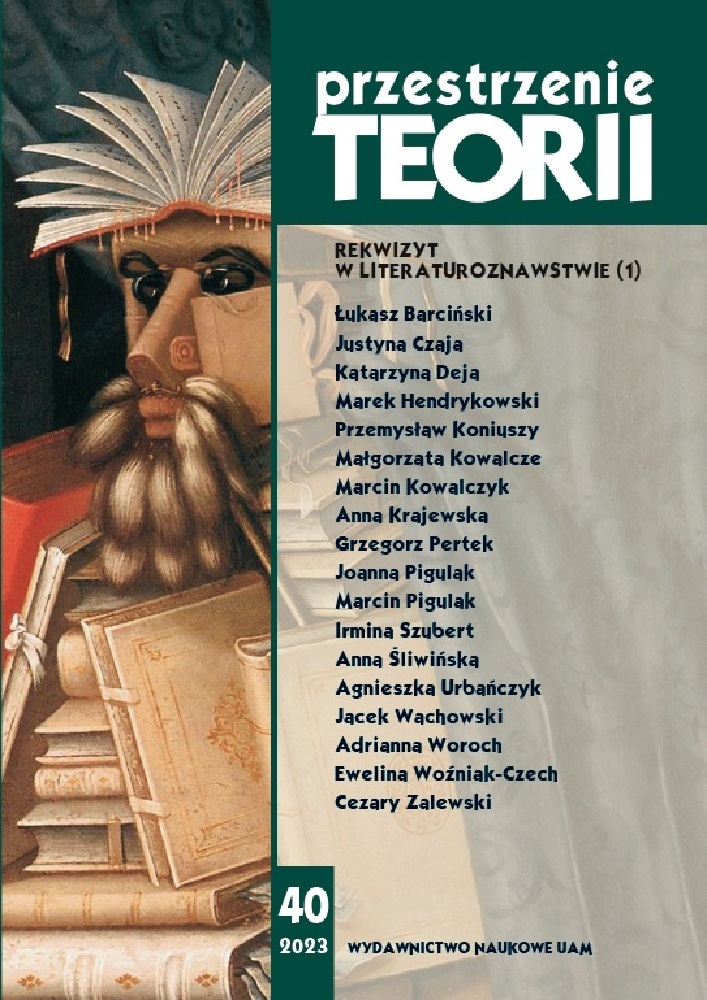Abstract
Barbie, the doll-symbol, the pop culture icon and significant prop on the artistic, political, social and business scenes, has been arousing emotions in subsequent generations for several decades. It is worth noting, however, that today Barbie is no longer just a passive instrument illustrating desired ideas, but has become a factor creating reality independent of her creators. In the present discussion, the author focuses on the interpretation of the phenomenon of Barbie perceived as an object and a thing in the sense of the Italian philosopher Remo Bodei. The article attempts to trace the transformation of the image of the Barbie doll from its creation to modern times, when its popularity peaked thanks to the excellent marketing strategy accompanying the distribution of Greta Gerwing’s 2023 film Barbie.
References
Adamczyk I., Fulla – Barbie w hidżabie. Analiza fenomenu i jego odbiór społeczny, [w:] Percepcja cywilizacji islamu w kulturze Zachodu, red. I. Adamczyk, T. Barańska et al., Kraków 2014.
Baudrillard J., Symulakry i symulacja, przeł. S. Królak, Warszawa 2005.
Biedroń i Czarzasty jako Ken, Kotula i Scheuring-Wielgus jako Barbie? Lewica naprawdę to zrobiła! „Ta Barbie walczy o legalną aborcję”, https://wpolityce.pl/polityka/655571-biedron-jako-ken-kotula-jako-barbie-alez-wyglup-lewicy (dostęp: 3.01.2024).
Bodei R., O życiu rzeczy, przeł. A. Bielak, Łódź 2016.
Gerber R., Barbie i Ruth, przeł. A Laskowska, Białystok 2023.
Gromysz J., Świat Barbie jako utopia ciała idealnego, [w:] Utopia a edukacja, red. J. Gromysz, R. Włodarczyk, Wrocław 2016.
Iran: Policja ściga za lalkę Barbie, https://www.newsweek.pl/swiat/iran-policja-sciga--za-lalki-barbie/gxwn8p1 (dostęp: 2.01.2024).
Jakubowski J., Rekwizyt jako narzędzie komunikowania politycznego, „Środkowoeuropejskie Studia Polityczne” 2012, nr 2. DOI: https://doi.org/10.14746/ssp.2012.2.05
Kijowski A.T., Chwyt teatralny (zarys instrumentalnej teorii teatru), Gdańsk 2000.
Kowalczyk I., Ciało i władza. Polska sztuka krytyczna lat 90., Warszawa 2002.
Kumala A., Barbie i słowo na „f”, https://krytykapolityczna.pl/kultura/film/barbie-i-slowo-na-f-recenzja-filmu/ (dostęp: 27.12.2023).
Maciejewski K., Rosjanie oszaleli na punkcie Barbie. Zakaz Putina nie zadziałał, https://biznes.interia.pl/gospodarka/news-rosjanie-oszaleli-na-punkcie-barbie-zakaz-putina-nie-zadzial,nId,6927891 (dostęp: 2.01.2024).
Milewski P., Lala Ameryka, https://www.newsweek.pl/swiat/lalka-barbie-jak-normalna-dziewczyna-rewolucja-mattel/vvlp6nf (dostęp: 5.01.2024).
Mudlaff P., Barbie nie poimprezuje w Wietnamie! Zakaz filmu z Margot Robbie, https://film.org.pl/news/barbie-nie-poimprezuje-w-wietnamie-zakaz-filmu-z-margot-robbie (dostęp: 5.01.2024).
Nowak W., Rzecz jako fetysz. O moralności konsumpcji, „Logos i Ethos” 2019, nr 2. DOI: https://doi.org/10.15633/lie.3482
Popko I., Kidult na zakupach świątecznych. Dlaczego dorośli kupują sobie zabawki?, https://sukces.rp.pl/piekne-rzeczy/art37650161-kidult-na-zakupach-swiatecznych-dlaczego-dorosli-kupuja-sobie-zabawki (dostęp: 3.01.2024).
Rogers M., Barbie jako ikona kultury, przeł. E. Klekot, Warszawa 2003.
Salam M., Mattel, maker of Barbie, debuts gender-neutral dolls, https://www.nytimes.com/2019/09/25/arts/mattel-gender-neutral-dolls.html (dostęp: 5.01.2024).
Savage D., Ken comes out, https://chicagoreader.com/news-politics/ken-comes-out/ (dostęp: 1.01.2024).
Taboł S. , Barbie – postmodernistyczny wymiar kultury, „Kultura i Edukacja” 2005, nr 1.
Wiącek E., Razanne, Sara, Fulla, Dżamila… Lalka polem walki i nośnikiem muzułmańskiego stylu życia na obszarze Bliskiego Wschodu, [w:] Kultura zabawy, red. M. Banaszkiewicz, T. Paleczny, R. Kantor, Kraków 2012.
Wójtowicz A., Baśki, ciotki i ikony, czyli Barbie w sztuce polskiej, https://magazynszum.pl/baski-ciotki-i-ikony-czyli-barbie-w-sztuce-polskiej/ (dostęp: 27.12.2023.
License
Copyright (c) 2023 Ewelina Woźniak-Czech

This work is licensed under a Creative Commons Attribution-NonCommercial-NoDerivatives 4.0 International License.
Authors
Authors of texts accepted for publication in Przestrzenie Teorii are required to complete, sign and return to the editor's office the Agreement for granting a royalty-free license to works with a commitment to grant a CC sub-license.
Under the agreement, the authors of texts published in Przestrzenie Teorii grant the Adam Mickiewicz University in Poznań a non-exclusive, royalty-free license and authorize the use of Attribution-NonCommercial-NoDerivatives 4.0 International (CC BY-NC-ND 4.0) Creative Commons sub-license.
The authors retain the right to continue the free disposal of the work.
Users
Interested Internet users are entitled to use works published in Przestrzenie Teorii since 2015, for non-commercial purposes only, under the following conditions:
- attribution - obligation to provide, together with the distributed work, information about the authorship, title, source (link to the original work, DOI) and the license itself.
- no derivatives - the work must be preserved in its original form, without the author's consent it is not possible to distribute the modified work, such as translations, publications, etc.
Copyrights are reserved for all texts published before 2015.
Miscellaneous
Adam Mickiewicz University in Poznań retains the right to magazines as a whole (layout, graphic form, title, cover design, logo etc.).

